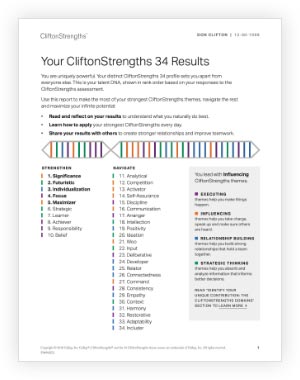Story Highlights
- PIPs require the investment of time and effort, with little return
- They encourage employees to reach the bare minimum, not excel
- A PDP produces better outcomes -- for the employee and the company
In theory, a performance improvement plan (PIP) is a step-by-step blueprint to put a struggling employee back on track.
In practice, PIPs are often disciplinary, last-ditch attempts to prevent termination (or, as many employees suspect, the harbinger of it). Either way, PIPs require the investment of time and effort, with a pitiful return -- an employee who stops screwing up, not one who does great work.
PIPs are a gracious way to exit employees, and that's not nothing.
But it's really not a kindness to demand improvement without offering the tools to make it happen, and slowing an employee's departure doesn't improve your profit and loss statement.
Performance development plans offer those tools and chart a path toward better employee performance -- and corporate profit. Gallup finds companies that invest in development achieve 11% greater profitability and twice the retention.
So, in this season of performance reviews, leaders have to ask themselves a logical question: Why throw good money away on PIPs -- and why wait for employees to fall apart before you start developing them?
All employees need the chance to learn and grow.
That's not a rhetorical question, and it has a real answer: because in many companies, development is considered an event or a reward.
There are two problems with that approach, and they both impede the returns you should get from development.
First, most people forget a majority of what they learn in a seminar within 24 hours, and almost all of it within 30 days -- even though, according to Forbes, corporate training and development cost U.S. businesses $88 billion in 2018. So, occasional conferences or seminars may give workers a performance bump, but it fizzles fast. That's why development events have so little impact on established relationships, habits and behaviors.
Second, making development an incentive does help employees chart their career, but it doesn't give them tools to improve their current work. It devalues the role as well. When development is a carrot, day-to-day work is a stick. Employees don't emotionally engage with sticks.
Yet, having the chance to learn and grow is fundamental to engagement -- and your finances. Gallup's recent meta-analysis shows that the most highly engaged teams have 81% less absenteeism, 64% fewer safety incidents (and 58% fewer patient safety incidents, in healthcare settings), 41% fewer quality defects, 18% higher sales productivity, 23% greater profitability and 66% better wellbeing.
So, because employees want development and it improves profitability, the next inevitable question is this: Shouldn't everyone be on a performance development plan?
You can implement a performance development plan for literally everyone.
That may sound extreme. After all, development is high-touch, time-intensive and individualistic. Is it really worth developing everyone?
Yes.
The best organizations Gallup has ever studied make development the cornerstone of their culture. Some of their learning and development offerings correspond to employee life cycle events -- onboarding, for example, or cybersecurity training -- but employee development is a core value and a daily mission.
Their managers are expected to focus on developing their teams, and some leaders tie employee development to manager pay. The performance development plans of those companies are laser-focused, role-specific, self-reinforcing and far more efficient than a PIP could be.
Having the chance to learn and grow is fundamental to engagement -- and your finances.
That approach requires a support system. The best companies incorporate their own values and culture into that system, but they all share these three traits:
- They teach their managers to be coaches, not bosses. These kinds of managers coach and develop workers through frequent, purposeful conversations. As a result, employees and managers create real relationships that clarify where development is most needed. And it makes development an everyday part of the job -- not an event, not a prize.
- They focus on individuals' strengths. Everyone has certain innate strengths that indicate their areas of greatest potential. Focusing on strengths individualizes development and amplifies its outcomes, and should be applied unanimously in companies to accelerate success in each role. And Gallup's meta-analysis of 1.2 million workers across 49,495 work units proved that teams that receive strengths-based development increase sales by 19% and profits by 29% while decreasing safety incidents by 59% and turnover by up to 72%.
- They position employees to do what they do best, every day. Matching talent to task -- such as putting the innately organized in process discussions or asking the empathetic to shepherd new hires -- increases the impact of strengths and coaching at the same time. And as Gallup's State of the American Workplace report shows, when eight in 10 employees can strongly agree that they have the opportunity to do what they do best every day, their companies realize 8% higher customer engagement scores and 14% better profitability.
This approach resembles the kind of experiential development that companies tend to reserve for top leaders, and it gets the same outcome: performance that adds value. But this approach enables granular, day-to-day improvement as it prompts managers and employees to collaborate on the means and aims of that development and pinpoint how employees can apply it.
As a result, accountability stays at the most local level, focusing on your most pressing needs and likely saving your company a great deal of money.
Create an employee development plan for a better ROI.
It's a lot easier to write up a PIP than to design a high-touch, time-intensive and individualistic performance development plan. But don't kid yourself: Your managers can put a lot of time and effort into helping failing employees without adding any value.
That's because PIPs don't add value. They're not meant to. They're a dodge. And that dodge, especially if your company reserves development as an incentive or an event, shorts employees' potential and your profitability while taxing your managers' time and energy.
And that presents leaders with a final, logical question: If you're going to invest in employee performance -- and one way or another, you are -- don't you want a better ROI than that?
Invest in your people. Do better business.
- Evolve performance management for better outcomes for your people and your bottom line.
- Give leaders and managers the development they need to develop all employees.
- Let us answer your questions about how human development can be an engine for your business.




